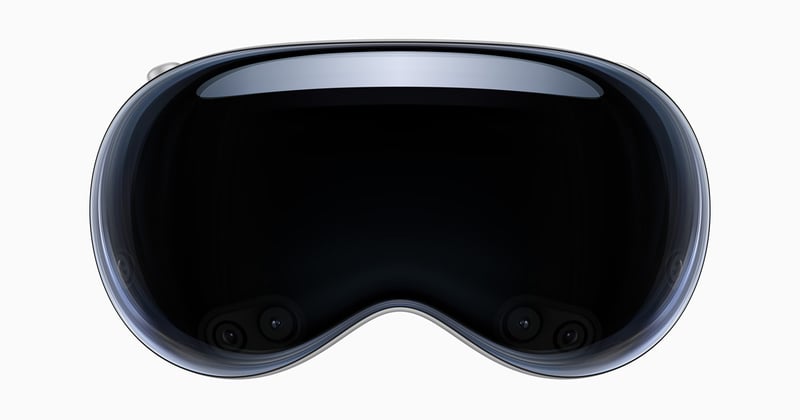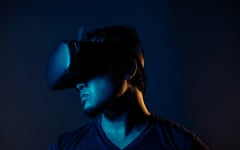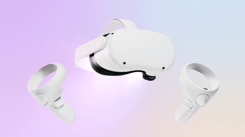The expression “When it rains it pours” is being felt this year when it comes to new VR/AR headset announcements. Hot on the heels of the announcement of the Meta Quest 3 we’ve finally gotten the announcement of the first Apple mixed reality headset. This headset announcement was rumored for some time, and we were very curious as to how Apple would market the headset and who the main audience would be. Well, now we have some answers.
The new headset seems to focus on augmented reality tech and boasts some impressive new features. We’re here to break down the Apple Vision Pro Features that have us the most excited or that have caught the public’s eye. From High resolutions screens to controller-free interfaces, there are a lot of new Apple Vision Pro features to cover.

Image Courtesy: Apple
AR is the main focus
The Apple Vision Pro features a major emphasis on AR in most of the marketing they have put out. Similar to the Meta Quest Pro they are showcasing the Apple Vision Pro as a tool for efficiency and multitasking. The main way we are seeing AR used is to create digital displays in the physical space around the viewer. They show someone browsing articles, looking at messages, and other common tasks using the device. They’ve also shown off how it can connect to other Apple devices such as Mac Books and use Apple services such as FaceTime.
They also try to showcase how it can be used to consume video media, allowing someone to feel like they are watching a movie or show on a large screen. However, one Apple Vision Pro feature that hasn’t been shown as much as its VR capabilities. They have shown that the Apple Vision Pro can create larger virtual environments but the only use case we’ve seen is for enhancing media viewing by creating larger more cinematic spaces.
What powers this AR is a similar assortment of sensors and cameras found in other AR/XR devices. However, Apple has consistently used the term “spatial computing” throughout the product description. The process of spatial computing seems to be a process of mapping the physical environment around the user at what seems to be a pretty high detail. This process of mapping allows the AR objects that Apple Vision Pro creates to appear like they actually do exist in the physical space of the user. This process tracks lighting, furniture, and even the acoustics of the room the user is in. This allows them to even create virtual shadows for the AR objects they create and add depth to their applications. And through the use of the spatial audio system, the headset can supposedly create a soundscape to make the audio feel like it surrounds the user.
Specification Breakdown
Now looking into the new Apple Vision Pro features, we actually do have some specific specs on some of the new additions to the headset.
- Chipset – We’ve learned that the Apple Vision Pro features a dual-chip design to accommodate the computing power needed to map and track the physical environment of the user. This includes Apple’s M2 chip as well as their brand-new R1 chip
- Screens – While we do not yet have the exact resolution of the displays in the headset, Apple has promised "more pixels than a 4K TV" for each eye. As well as the use of a micro-OLED screen.
- Cameras and Sensors – There are many cameras on the headset that are for tracking the environment as well as your hand gestures (The main way of navigating in the headset). However, there are even 4 infrared cameras in the headset that are used to track your eyes. This means your eyes can be used for navigation and for video calls.
- Battery – Unlike other standalone headsets, the battery is not actually located in the main headset unit. Instead, a cable attached to the band leads to an external battery pack that can be carried in the user’s pocket.
With this plethora of high-end specs, there comes a high-end price tag. The Apple Vision Pro features a $3500 USD price tag, far more than many other standalone VR/AR devices on the market currently. The price came as a shock to some and the internet has had mixed reactions to the price. The bulk of this price likely comes from the new screens they’ve developed as well as the many cameras and sensors. So time will tell if the headset is worth the price of admission.
One other caveat worth mentioning is the battery life. Because the headset is so demanding, it does take quite a toll on the battery. At current reports, the battery life of the Apple Vision Pro is about 2 hours or so. However, you can plug it directly into an outlet and make it last all day, but that does remove the portable aspect of the headset.
Where it fits in our industry
As we look to the future launch of the Apple Vision Pro, as we do with any XR device, we are looking to see where it can fit in our industry. When we look at AR and VR, we utilize them mostly as presentation tools to help transport architecture and design clients. We consider it something that you can share with others and combine with existing presentation tools. One thing we noticed about the Apple Vision Pro, is that it seemed to be something personal, and one would use it on their own. They didn’t really highlight how it could be used as a presentation tool, instead showcasing it as a tool for solitary work and efficiency. Obviously, this can still change and will be dependent on the apps that get developed for the device. But at the moment we will have to wait and see what happens.
If you want to learn more about other recent AR/VR device announcements, check out our feature breakdowns on both the Meta Quest Pro and the Meta Quest 3. If you’re still on the fence about whether or not you should adopt VR/AR into your business, check out our article on why early adopters will have the advantage.




.jpg?width=245&height=150&name=BUSINESS-READY-VR-63-1%20(1).jpg)
